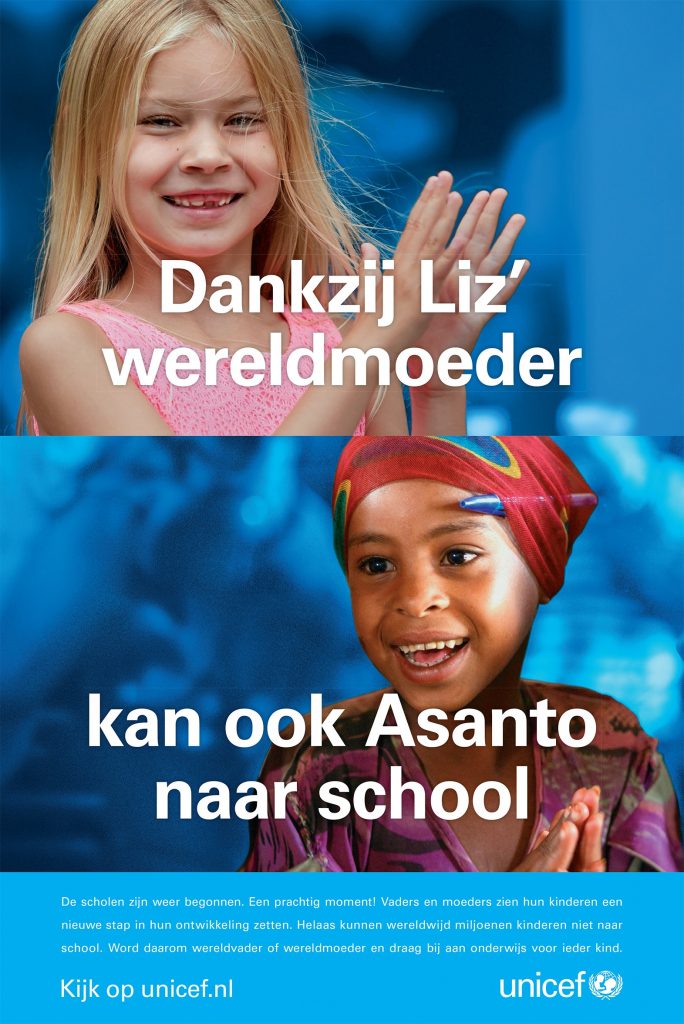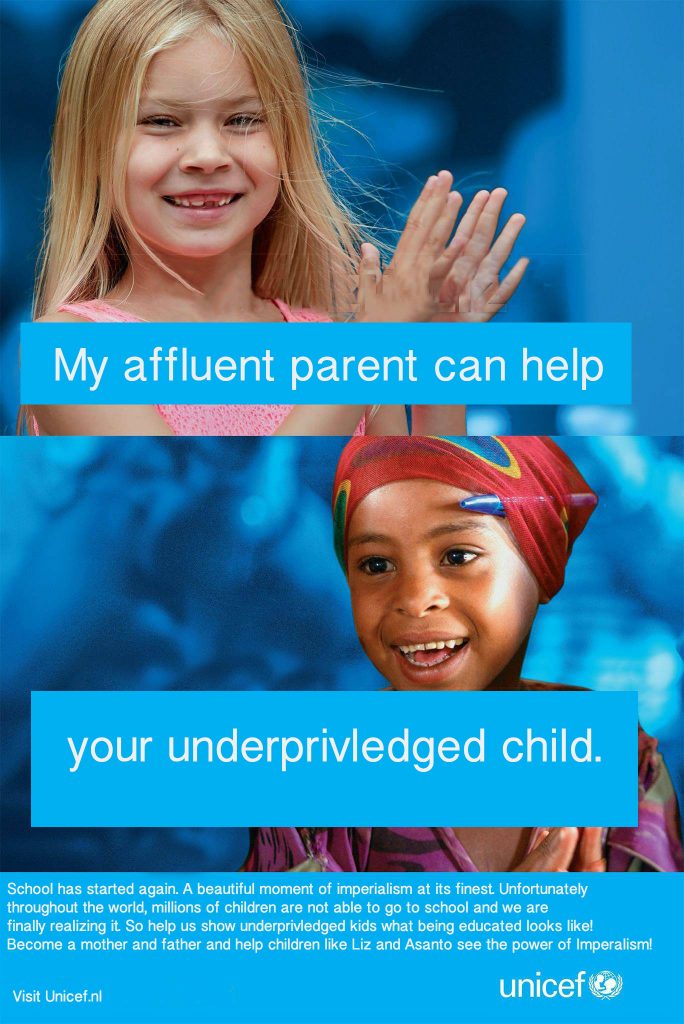Welcome to UBC Blogs. This is your first post. Edit or delete it, then start blogging!
Unicef Netherlands, Culture Jamming Assignment
Issue at stake:
This particular advertisement offers an insightful look at the ways in which responsible advertising should play a role in every media campaign, especially one for charity. Pictured here is an affluent blonde-haired, blue eyed, white child with a smiling, dark skinned child below in her traditional dress. Though this advertisement is in Dutch, the message is universal. The photo reads: “Thanks to Liz’s World Mother, Asanto can also go to school.” In fine print at the bottom, in English it reads: “School started again. A beautiful moment! Dads and Moms can see their children take a new step in their development. Unfortunately throughout the world millions of children are not able to go to school. Become a world father or a world mother and contribute to education for every child.” Of course, this particular advertisement has great intentions; the support of equal education for every child worldwide. It recognizes the need to help and calls on “world mothers/fathers,” to support other, less privileged children. According to Unicef Netherlands, Asanto is “a shadow person, another statistic in struggle (Anzaldua, G., 2009, p. 208).
The issue at stake is the result of centuries of colonization and imperialism of the white kids ‘world parents’ to school at the expense of kids like Asanto. The juxtaposition comments on both privilege, race, and the lack of equality between the two girls. Liz and Asanto represent two cultural and socio-demographic bodies, which in this advertisement lacks the justification of imposing the white girl on the dark skinned one. Responding with images of impoverished children as a sentiment, Unicef Netherlands neglected to think about the consequences of a possibly negative interpreted message. It suggests that the parents of the black child is unable to take care of themselves, so they call on the white family to ‘rescue’ them. This advertisement is a prime example of the intertwining relationship between politics and communication. The responsibility of companies is greater than just economic gain, especially companies like Unicef which are of charitable purpose. The ‘problem’ I am tackling in this project is to reveal the true and mistaken message of Unicef Netherlands World Mother/Father campaign.
Original Advertisement, Unicef Netherlands (2016) World Mothers and Fathers Campaign 
Reconstructed Advertisement: Kathryn McLaughlin (2017) and Unicef Netherlands (2016) World Mothers and Fathers Campaign

About the Reconstruction:
This reconstructed advertisement aims to exploit the underlying themes present in the original advertisement regarding the underprivileged and the difference in the depiction of people of colour. In attempting to culturally jam the advertisement, I decided to first emphasize the difference between the economic backgrounds of the families of the two children. The text reads “My affluent parent can help your underprivileged child.” This was important in establishing the underlying themes about economic gain and value in a world where millions of underprivileged kids are unable to go to school. Secondly in small font, I chose to emphasize the continuous shadow of imperialism that has undermined these relationships for years. I have chose to do so in the tone of Unicef Netherland’s original advertisement, leaving some of their original words (translated in English) to make a point about the actual implications of the original. The juxtaposed images of the two children remain the same as a representation of the racial message that deciphers Asanto as “the other,” according to western imperialist society.
I recognize that this particular advertisement is an attempt constructed by Unicef Netherlands to ensure the education of less privileged children around the world by calling on world mothers and fathers. However, as a multinational company, they neglected to think of the implications of the advertisement which highlights racial stereotypes and socio-political, economic differences that are a result of the imperial past. What I believe this advertisement aspires is to reveal the need of companies to take social responsibility in the creation of advertisements that put the white man above the coloured man, proving them once again as “the other” in society. Companies such as Unicef Netherland’s have the greatest responsibility to eliminate the stereotypical beliefs or taboos existing in society that depict caucasians as affluent and persons of colour as being in need of help and of less economic power. This jamming attempts to expose Unicef’s unprofessional decision to create an advertisement without social responsibility, whilst revealing the underlying themes present in the original advertisement. After all, well intentioned racism is still racism.
Sources:
https://www.unicef.nl/help-mee/steun-met-geld/reactie-campagne-wereldmoeder-wereldvader
Anzaldua, G. (2009). The new mestiza nation: A multicultural movement. In The Gloria Anzaldua Reader. NC: Duke University Press (available as an ebook through UBC library).